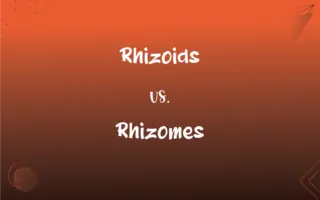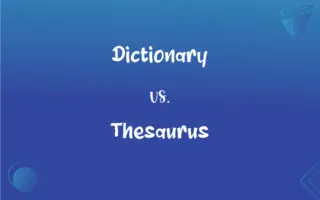Homology vs. Homoplasy: What's the Difference?
Edited by Aimie Carlson || By Harlon Moss || Updated on October 27, 2023
Homology indicates traits inherited from a common ancestor, while homoplasy refers to similar traits evolved independently.

Key Differences
Homology and homoplasy are terms often used in evolutionary biology to describe traits in different organisms. Homology refers to the similarity in traits or structures due to shared ancestry. That is, if two species have a similar trait because they both inherited it from a common ancestor, that trait is considered homologous. Conversely, homoplasy denotes similarities not derived from common ancestry but rather from convergent evolution or other processes.
In understanding evolutionary relationships, homology is a central concept. For example, the wing of a bat and the arm of a human are homologous structures; both evolved from the forelimb of a common ancestor. In contrast, homoplasy can be seen in the wings of bats and birds. While both have wings, they didn't inherit this trait from a shared winged ancestor. Instead, wings evolved independently in each lineage.
One of the challenges in evolutionary biology is distinguishing between homology and homoplasy. This is because, at first glance, traits may seem similar and lead to the assumption of a shared ancestry. However, upon closer inspection and through genetic research, some of these traits may be found to have evolved independently, classifying them as homoplastic. In essence, while homology points to shared evolutionary pathways, homoplasy underscores the capacity of different species to develop similar features independently.
In the realm of evolutionary studies, homology provides evidence for the evolutionary relationships between species. When scientists find homologous structures, they can trace back to where lineages diverged from a common ancestor. Homoplasy, on the other hand, showcases nature's tendency to shape different species in similar ways based on the demands of their environments or niches.
In summary, both homology and homoplasy are crucial concepts in deciphering the evolutionary history of life. While homology signals a shared ancestry, homoplasy highlights independent, yet similar, evolutionary outcomes.
ADVERTISEMENT
Comparison Chart
Definition
Similarity due to shared ancestry.
Similarity evolved independently.
Evolutionary Basis
Common ancestry.
Convergent evolution or other processes.
Example
Wing of a bat and arm of a human.
Wings of bats and birds.
Genetic Linkage
Often linked to shared genetic heritage.
Not necessarily linked to shared genetics.
Evolutionary Significance
Offers evidence of evolutionary relationships between species.
Demonstrates nature's ability to shape species similarly.
ADVERTISEMENT
Homology and Homoplasy Definitions
Homology
Structures in different species that are alike because of shared ancestry.
Studying the homology in mammalian ear bones helps trace evolutionary lineage.
Homoplasy
Evolutionary trait similarity not derived from shared ancestry.
The presence of wings in insects and birds is an example of homoplasy.
Homology
Similarity in organisms due to shared ancestry.
The homology between human and chimpanzee DNA indicates a recent common ancestor.
Homoplasy
Independent evolution of similar features in different species.
Despite their environmental differences, cacti and some succulents show surprising homoplasy.
Homology
Genetic or physical similarities in organisms from common descent.
The homology in certain genes among mammals is a topic of extensive research.
Homoplasy
Traits in different species that appear similar but aren't due to common ancestry.
The streamlined bodies of sharks and dolphins are a fascinating study in homoplasy.
Homology
The study of likeness in structure between parts of different organisms.
Through understanding homology, scientists can uncover evolutionary relationships.
Homoplasy
The result of convergent evolution in separate lineages.
The ability to fly evolved multiple times in different groups, a classic case of homoplasy.
Homology
Traits inherited from a common evolutionary predecessor.
The bone structures in whale fins and human hands display a clear homology.
Homoplasy
Similarity in traits or structure without a shared evolutionary history.
The prickly spines in hedgehogs and porcupines are instances of homoplasy.
Homology
The quality or condition of being homologous.
Homoplasy
Correspondence between parts or organs arising from evolutionary convergence.
Homoplasy
(evolutionary theory) A correspondence between the parts or organs of different species acquired as the result of parallel evolution or convergence.
Homoplasy
See Homogeny.
FAQs
Why is homology important in evolutionary biology?
Homology provides evidence of shared ancestry and evolutionary relationships between species.
How is homoplasy different from homology?
Homoplasy denotes traits that are similar due to independent evolution, not shared ancestry.
Can you give an example of homology?
An example of homology is the similarity between the human hand and the bat wing, as they evolved from a common ancestral forelimb.
Are genetic similarities always indicative of homology?
Not always. While genetic similarities often point to homology, they can also arise from independent evolutionary events, leading to homoplasy.
How do scientists distinguish between homology and homoplasy?
Scientists use genetic research and a deep study of morphology to discern between homology and homoplasy.
Can homoplasy be misleading in determining evolutionary relationships?
Yes, because homoplasic traits are independently evolved, they can lead to false assumptions about shared ancestry.
Can homoplasy occur in plant evolution?
Absolutely, homoplasy can be observed in plants where different species evolve similar adaptations.
Does homoplasy complicate the study of evolutionary trees?
Yes, homoplasy can make it challenging to deduce true evolutionary relationships based solely on trait similarities.
How can one determine if a trait is a result of homology or homoplasy?
Detailed genetic and morphological studies, combined with knowledge of evolutionary history, help determine the origin of a trait.
Can two species share both homologous and homoplastic traits?
Yes, it's possible for species to have traits that are both inherited from a common ancestor (homology) and traits evolved independently (homoplasy).
Is homology evidence for evolution?
Yes, homology provides strong evidence for common ancestry and the evolutionary relationships between species.
Is homoplasy common in nature?
Yes, homoplasy occurs frequently as different species often evolve similar solutions to similar challenges.
Is the concept of homology restricted only to physical traits?
No, homology can also refer to genetic, molecular, or behavioral similarities due to shared ancestry.
What's a common example of homoplasy?
The wings of bats and birds represent homoplasy as they evolved independently.
Are there degrees of homoplasy?
Yes, some traits may be more or less similar due to varying degrees of convergent evolution or other factors.
What is homology?
Homology refers to the similarity in organisms due to shared ancestry.
Are all similar traits in animals examples of homology?
No, similar traits can arise from homology (shared ancestry) or homoplasy (independent evolution).
What role do environmental pressures play in homoplasy?
Environmental pressures can lead to convergent evolution, where unrelated species evolve similar traits in response, resulting in homoplasy.
Can homoplasy be found in genetic sequences?
Yes, similar genetic sequences in different species can arise independently, leading to genetic homoplasy.
What causes homoplasy in evolution?
Homoplasy can result from convergent evolution, where different species face similar environmental challenges and evolve similar solutions.
About Author
Written by
Harlon MossHarlon is a seasoned quality moderator and accomplished content writer for Difference Wiki. An alumnus of the prestigious University of California, he earned his degree in Computer Science. Leveraging his academic background, Harlon brings a meticulous and informed perspective to his work, ensuring content accuracy and excellence.
Edited by
Aimie CarlsonAimie Carlson, holding a master's degree in English literature, is a fervent English language enthusiast. She lends her writing talents to Difference Wiki, a prominent website that specializes in comparisons, offering readers insightful analyses that both captivate and inform.































































